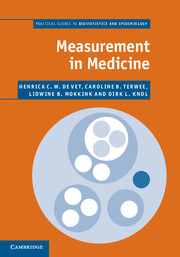Book contents
- Frontmatter
- Contents
- Preface
- 1 Introduction
- 2 Concepts, theories and models, and types of measurements
- 3 Development of a measurement instrument
- 4 Field-testing: item reduction and data structure
- 5 Reliability
- 6 Validity
- 7 Responsiveness
- 8 Interpretability
- 9 Systematic reviews of measurement properties
- References
- Index
7 - Responsiveness
Published online by Cambridge University Press: 07 September 2011
- Frontmatter
- Contents
- Preface
- 1 Introduction
- 2 Concepts, theories and models, and types of measurements
- 3 Development of a measurement instrument
- 4 Field-testing: item reduction and data structure
- 5 Reliability
- 6 Validity
- 7 Responsiveness
- 8 Interpretability
- 9 Systematic reviews of measurement properties
- References
- Index
Summary
Introduction
The ultimate goal of medicine is to cure patients. Therefore, assessing whether the disease status of patients has changed over time is often the most important objective of measurements in clinical practice and clinical and health research. In Section 3.2.3, we stated that we need measurement instruments with an evaluative purpose or application to detect changes in health status over time. These instruments should be responsive. Responsiveness is defined by the COSMIN panel as ‘the ability of an instrument to detect change over time in the construct to be measured’ (Mokkink et al., 2010a). In essence, when assessing responsiveness the hypothesis is tested that if patients change on the construct of interest, their scores on the measurement instrument assessing this construct change accordingly. The approach to assess responsiveness is quite similar as for validity, as we will show in this chapter. In Section 7.2, we will start by elaborating a bit more on the concept of responsiveness. We will discuss the relationship between responsiveness and validity, taking responsiveness as an aspect of validity, in a longitudinal context. We will also elaborate on the definition of responsiveness and the impact of this definition on the assessment of responsiveness.
- Type
- Chapter
- Information
- Measurement in MedicineA Practical Guide, pp. 202 - 226Publisher: Cambridge University PressPrint publication year: 2011
- 6
- Cited by



